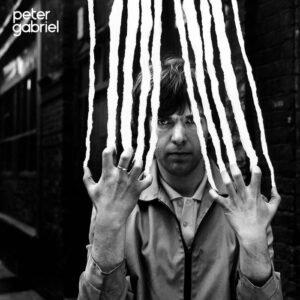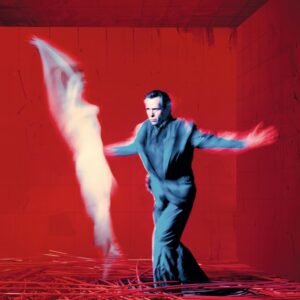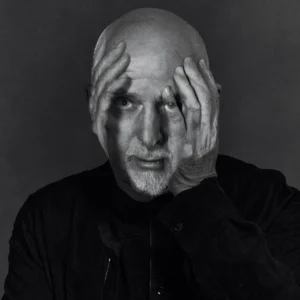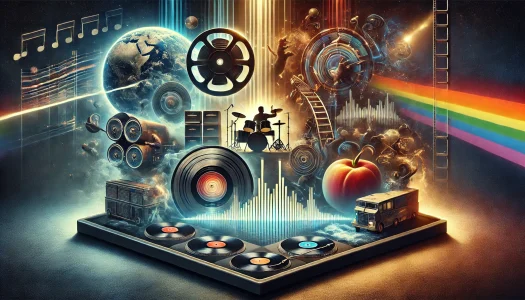Few artists in the history of modern music can claim the breadth, depth, and daring of Peter Gabriel. From his formative years as the charismatic frontman of Genesis to his solo career that redefined what pop music could achieve, Gabriel has remained a creative force, constantly pushing the boundaries of sound, technology, and artistic expression. We undertake a comprehensive journey through his remarkable career, exploring the studio albums that defined his voice, the B-sides that deepened his narrative, and the diverse projects that showcased his unparalleled curiosity and innovation.
Studio Albums
Peter Gabriel I (1977 – “Car”)

Peter Gabriel’s first solo album announced his departure from Genesis with a mix of introspection and theatrical flair. Produced by Bob Ezrin, the album blends art rock with a newfound accessibility, highlighted by the enduring “Solsbury Hill,” a poignant reflection on his decision to leave the band. The track’s rolling 7/4 time signature and uplifting melody set the tone for Gabriel’s career as a solo artist unafraid of experimentation. Other standout tracks, like the eerie “Moribund the Burgermeister” and the epic “Here Comes the Flood,” showcased Gabriel’s narrative lyricism and his willingness to dive into emotional depths, establishing his identity as a solo artist.
Peter Gabriel II (1978 – “Scratch”)

For his sophomore album, Gabriel enlisted the help of King Crimson’s Robert Fripp as producer, resulting in an edgier, more experimental sound. Scratch explored themes of alienation and paranoia, with tracks like “Mother of Violence” emphasizing stripped-down arrangements that contrasted with the fuller production of his debut. The frenetic “D.I.Y.” captured a raw punk energy, while “White Shadow” hinted at Gabriel’s penchant for atmospheric textures. Despite its eclectic nature, the album’s cohesion lies in its vulnerability and willingness to challenge conventional rock aesthetics.
Peter Gabriel III (1980 – “Melt”)

Considered a watershed moment in Gabriel’s career, Melt saw him embrace groundbreaking production techniques and tackle deeply personal and political themes. Working with producer Steve Lillywhite, Gabriel pioneered the use of gated reverb, giving the album its stark, percussive sound. Tracks like “Intruder” and “No Self Control” were haunting and claustrophobic, while “Biko,” inspired by the South African anti-apartheid activist, became a rallying cry for social justice. Melt was both a commercial and critical success, solidifying Gabriel as a leader in experimental rock.
Peter Gabriel IV (1982 – “Security”)

Gabriel’s fourth album took his exploration of world music and advanced production techniques to new heights. Tracks like “Rhythm of the Heat” and “San Jacinto” drew inspiration from African drumming and Native American storytelling, blending these influences with electronic instrumentation. The single “Shock the Monkey” became an international hit, marrying tribal rhythms with synth-driven pop. Gabriel’s meticulous layering of sound created an immersive listening experience, reflecting his deepening interest in global musical traditions and his role as a cultural bridge-builder.
So (1986)

So marked a major shift in Gabriel’s career, catapulting him into global superstardom while maintaining his artistic integrity. Produced by Daniel Lanois, the album delivered a suite of emotionally resonant tracks, from the joyful, horn-driven “Sledgehammer” to the tender “Don’t Give Up,” featuring Kate Bush. Gabriel’s ability to marry accessible pop structures with layered, introspective themes made So a landmark album. Songs like “Red Rain” and “In Your Eyes” showcased his gift for storytelling and emotional connection, while the album’s innovative music videos redefined visual storytelling in the MTV era.
Us (1992)

Deeply introspective, Us delved into themes of love, loss, and identity, reflecting Gabriel’s personal struggles and relationships. Tracks like “Come Talk to Me” and “Love to Be Loved” are lushly orchestrated meditations on intimacy, while “Digging in the Dirt” explores the darker recesses of the psyche. The album’s global influences, bolstered by Gabriel’s work with musicians from Real World Records, added layers of texture to the music. The poignant “Blood of Eden” and the cathartic “Secret World” cemented Us as one of Gabriel’s most emotionally raw and complex works.
Up (2002)

After a decade-long hiatus, Gabriel returned with Up, an album that confronted mortality and the passage of time with unflinching honesty. The opener, “Darkness,” juxtaposes unsettling lyrics with intricate rhythms, reflecting Gabriel’s mastery of dynamics. “Sky Blue” and “I Grieve” offer moments of poignant beauty, grappling with loss and resilience. Produced with meticulous attention to detail, Up marries electronic experimentation with organic instrumentation, showcasing Gabriel’s ability to evolve his sound while staying true to his introspective roots.
i/o (2023)

i/o, Peter Gabriel’s long-anticipated tenth studio album, is a monumental return to original material after a 21-year hiatus since Up. Released in December 2023, the album showcases Gabriel’s hallmark fusion of art rock and global influences, featuring collaborations with luminaries such as Brian Eno and the Soweto Gospel Choir. Thematically expansive, i/o reflects on humanity’s interconnectedness, addressing themes of surveillance, hope, and renewal. Its innovative release strategy—unveiling one track per full moon throughout the year—allowed fans to immerse themselves in its journey gradually. With dual mixes for each track, the “Bright-Side Mix” by Mark ‘Spike’ Stent and the “Dark-Side Mix” by Tchad Blake, the album offers layered sonic experiences.
B-Sides and Hidden Gems: The Lesser-Known Masterpieces
Peter Gabriel’s creative output extends far beyond the tracks that made it onto his studio albums. His B-sides, demos, and live rarities reveal an artist whose curiosity and experimentation couldn’t be confined to the official releases. These hidden gems offer fans a deeper look into his process and serve as a treasure trove of material that complements, and often contrasts, his better-known work.
B-Sides Across Albums
Peter Gabriel’s B-sides are a testament to his layered artistry, offering tracks that might not have fit the thematic arc of an album but are no less compelling. One standout is “Across the River,” an instrumental piece with a hypnotic groove that showcases Gabriel’s knack for cinematic soundscapes. Originally a B-side for the Shock the Monkey single, it later became a staple of his live shows. Another gem is “Shosholoza,” a collaborative track inspired by a traditional South African work song, recorded during the So sessions. Its rich harmonies and rhythmic energy highlight Gabriel’s commitment to celebrating global music traditions. These B-sides often feel like extensions of their parent albums, offering new dimensions to their sonic and thematic worlds.
Demos and Unreleased Songs
For fans who have ventured into bootlegs and compilations, Gabriel’s unreleased tracks and demos are a goldmine. Songs like “Don’t Break This Rhythm,” an outtake from the So sessions, carry the same rhythmic precision and atmospheric depth that defined the album but lean more experimental in structure. Similarly, “Courage,” a shelved track from the Us era, was eventually polished and officially released, revealing a raw vulnerability that complements the deeply personal themes of the album.
Some demos, such as early versions of “Here Comes the Flood,” offer fascinating glimpses into Gabriel’s creative process, showcasing how his ideas evolved before reaching their final form. These tracks underline Gabriel’s perfectionism—songs were often set aside not because they lacked quality, but because they didn’t align with his exacting vision for an album.
Live Rarities
Peter Gabriel’s live performances are renowned for their theatricality and emotional resonance, and many of his live-only tracks have achieved cult status among fans. One notable example is his stirring rendition of “Here Comes the Flood” performed solo on piano, stripping the track of its original bombast to reveal its poignant core. Another highlight is the live version of “I Go Swimming,” a buoyant, rhythm-heavy track that energizes audiences but has never appeared on a studio album. Gabriel’s live reinterpretations often breathe new life into his catalog, presenting familiar songs with fresh arrangements or unexpected improvisations. These performances, often recorded and shared among fans, capture the immediacy and emotional depth that make his live shows unforgettable.
Other Projects: Beyond the Studio Albums
While Peter Gabriel’s studio albums are the backbone of his legacy, his artistic reach extends far beyond the confines of traditional releases. From evocative film soundtracks and transformative world music initiatives to boundary-pushing theatrical works and iconic collaborations, Gabriel’s ventures showcase his boundless creativity and commitment to innovation.
Film Soundtracks
Gabriel’s foray into film scoring began with Birdy (1985), a hauntingly atmospheric soundtrack for Alan Parker’s film of the same name. Using reworked versions of tracks from his earlier albums, Gabriel crafted an ethereal soundscape that captured the psychological intensity of the story. His next major cinematic project, Passion: Music for The Last Temptation of Christ (1989), is a masterpiece that blends Middle Eastern instrumentation with modern electronic textures.
The album, inspired by Martin Scorsese’s controversial film, transcends its role as a soundtrack to stand as a landmark in the integration of world music into Western composition. These projects not only highlighted Gabriel’s talent for creating evocative, narrative-driven music but also revealed a different side of his artistry—one that prioritized mood and texture over conventional song structure.
World Music and WOMAD
Gabriel’s passion for global sounds culminated in his founding of WOMAD (World of Music, Arts and Dance) in 1982, an initiative that celebrates music from diverse cultures around the world. The festival, which continues to this day, became a platform for introducing global artists to Western audiences. Simultaneously, Gabriel launched Real World Records, a label dedicated to supporting and promoting world music artists such as Nusrat Fateh Ali Khan, Youssou N’Dour, and Ayub Ogada. Gabriel’s commitment to cultural exchange not only enriched his own music—evident in albums like Us and Passion—but also elevated global music to new levels of visibility and respect within the industry.
Theatrical and Conceptual Works
Gabriel’s ventures into multimedia and conceptual art are another testament to his creative vision. One of his most ambitious projects, OVO, was composed for the Millennium Dome Show in 2000. Combining themes of mythology and futurism with music, acrobatics, and visual storytelling, OVO exemplifies Gabriel’s fascination with creating immersive experiences. Other conceptual endeavors, such as his Growing Up and Back to Front tours, featured elaborate stage designs and theatrical elements that transformed his live shows into multi-sensory spectacles. These projects blurred the line between concert and performance art, further solidifying Gabriel’s reputation as a trailblazer.
Collaborations
Throughout his career, Gabriel has cultivated collaborations that have expanded his musical horizons. His partnership with Kate Bush on “Don’t Give Up” remains one of the most iconic duets in music history, blending their distinctive voices in a moving exploration of perseverance. Gabriel’s work with Youssou N’Dour on “In Your Eyes” and “Shaking the Tree” introduced millions to N’Dour’s artistry and underscored Gabriel’s ability to bridge cultures. Collaborations with experimental artists like Brian Eno pushed the boundaries of his sound, particularly in the realms of ambient and electronic music. These partnerships not only influenced Gabriel’s creative direction but also reinforced his belief in the collaborative nature of art.
Conclusion: The Legacy of an Innovator
Peter Gabriel’s career stands as a testament to the power of reinvention, collaboration, and unrelenting curiosity. From the introspective musings of his self-titled albums to the jubilant anthems of So and the introspective depths of Us and Up, Gabriel’s studio work has continually evolved, pushing the boundaries of sound and storytelling. His hidden gems—B-sides, demos, and live rarities—offer further glimpses into his creative process, showcasing an artist unafraid to experiment and leave behind a trail of treasures for devoted fans to discover.
Beyond his albums, Gabriel’s ventures into film scoring, world music advocacy, and immersive multimedia art have enriched his legacy, proving that his artistry transcends traditional musical formats. Through groundbreaking initiatives like WOMAD and Real World Records, he has amplified the voices of artists from around the globe, challenging listeners to engage with the world’s rich cultural diversity. His theatrical live performances and innovative collaborations have similarly blurred the lines between music, art, and technology, leaving an indelible mark on audiences and peers alike.
Together, these threads weave a portrait of an artist whose influence extends far beyond his catalog. Gabriel’s work is not merely to be listened to but to be explored, felt, and experienced in its vast and varied dimensions. His legacy invites us to delve into the depth of his discography, uncover the lesser-known corners of his artistry, and reflect on the ways his music continues to inspire and connect us. Peter Gabriel is not just a musician; he is a visionary who has redefined what it means to create, leaving an enduring imprint on music and culture.
